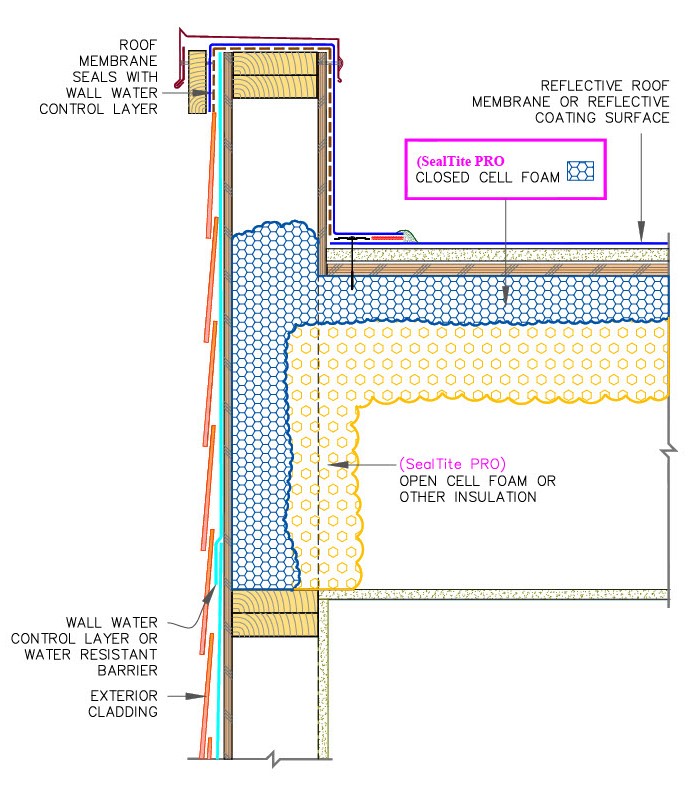Eliminating Condensation Risks of Cool Roofs with SPF
In warm climates, cool roofs that use white EPDM, TPO, or PVC can offer energy savings by reflecting more sunlight and absorbing less heat than a darker-colored roof. However, white membranes may increase the risk of condensation forming in the roofing system.
The basic principles related to condensation issues that can occur with white membranes – particularly in colder, northern climates – are well understood.
Warm, humid air migrates upward during cold weather and infiltrates the roofing assembly through gaps (wall-to-deck), unsealed joints (steel deck end laps), or around penetrations. Moisture within the humid air begins condensing once it encounters a surface temperature below the dew point. This typically occurs on the underside of the membrane and can create the appearance of mystery leaks inside the building. The longer the surface remains below the dew point, the more condensation will collect if the vapor migration continues.
Because of their reflectivity, cool roofs often fall below – and remain below – the dew point for longer periods than darker roofs. The same phenomenon that keeps the roof cool can make it more susceptible to condensation and moisture drips, especially in central and northern climates.
A single inch of Carlisle Spray Foam Insulation's SealTite PRO Closed Cell Spray Polyurethane Foam (SPF) insulation applied directly to the underside of the roof deck can effectively eliminate the condensation risk while maintaining the benefits of a cool roof.
SealTite PRO Closed Cell is a multifunctional building material that delivers three levels of protection – thermal, air, and moisture. A single inch offers an R-value of 6.9, is air impermeable, and is a class 2 vapor retarder. SealTite PRO Closed Cell adapts and adheres to any surface, shape, and geometry, and expands to fill the smallest holes and gaps for a completely monolithic and seamless environmental barrier. SealTite PRO Closed Cell can be combined with open cell spray foam insulation or traditional fibrous insulation to attain target roof insulation values in a hybrid assembly as shown in Figure 1.

For more information about Carlisle Spray Foam Insulation products, click here.
For a complete listing of CSFI's specifications and details, click here.
Contact Kevin Wiacek with questions.
The basic principles related to condensation issues that can occur with white membranes – particularly in colder, northern climates – are well understood.
Warm, humid air migrates upward during cold weather and infiltrates the roofing assembly through gaps (wall-to-deck), unsealed joints (steel deck end laps), or around penetrations. Moisture within the humid air begins condensing once it encounters a surface temperature below the dew point. This typically occurs on the underside of the membrane and can create the appearance of mystery leaks inside the building. The longer the surface remains below the dew point, the more condensation will collect if the vapor migration continues.
Because of their reflectivity, cool roofs often fall below – and remain below – the dew point for longer periods than darker roofs. The same phenomenon that keeps the roof cool can make it more susceptible to condensation and moisture drips, especially in central and northern climates.
A single inch of Carlisle Spray Foam Insulation's SealTite PRO Closed Cell Spray Polyurethane Foam (SPF) insulation applied directly to the underside of the roof deck can effectively eliminate the condensation risk while maintaining the benefits of a cool roof.
SealTite PRO Closed Cell is a multifunctional building material that delivers three levels of protection – thermal, air, and moisture. A single inch offers an R-value of 6.9, is air impermeable, and is a class 2 vapor retarder. SealTite PRO Closed Cell adapts and adheres to any surface, shape, and geometry, and expands to fill the smallest holes and gaps for a completely monolithic and seamless environmental barrier. SealTite PRO Closed Cell can be combined with open cell spray foam insulation or traditional fibrous insulation to attain target roof insulation values in a hybrid assembly as shown in Figure 1.

For more information about Carlisle Spray Foam Insulation products, click here.
For a complete listing of CSFI's specifications and details, click here.
Contact Kevin Wiacek with questions.
Up Next
July 21, 2021
Low-GWP Blowing Agents for Insulation and Adhesives
The United States and Canada have adopted regulations that prohibit the manufacture and use of common insulation products that are produced with blowing agents characterized as having high global warming potential (GWP).
July 15, 2021
SpecTips - Maintain a Clean and Reflective Membrane During Installation with APEEL Protective Film
APEEL™ Protective Film–Now Available for PVC & KEE HP Membranes
July 07, 2021
Ballasted Roofs and SRI Values
Choosing a ballasted design in lieu of an adhered or mechanically fastened assembly doesn’t mean you’re giving up the option of having a reflective roof. Pavers can be used to achieve a white, tan, or light gray roof that meets reflectance values for LEED and/or California’s Title 24.

